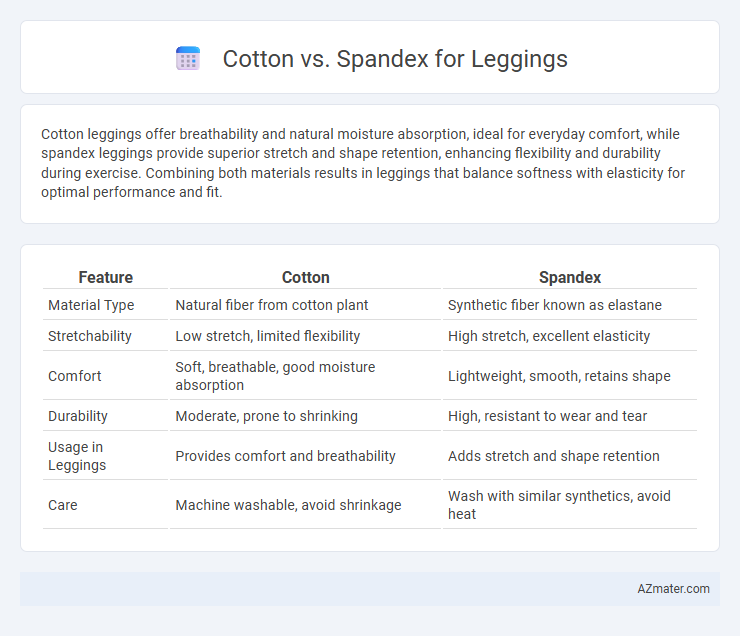Cotton leggings offer breathability and natural moisture absorption, ideal for everyday comfort, while spandex leggings provide superior stretch and shape retention, enhancing flexibility and durability during exercise. Combining both materials results in leggings that balance softness with elasticity for optimal performance and fit.
Table of Comparison
| Feature | Cotton | Spandex |
|---|---|---|
| Material Type | Natural fiber from cotton plant | Synthetic fiber known as elastane |
| Stretchability | Low stretch, limited flexibility | High stretch, excellent elasticity |
| Comfort | Soft, breathable, good moisture absorption | Lightweight, smooth, retains shape |
| Durability | Moderate, prone to shrinking | High, resistant to wear and tear |
| Usage in Leggings | Provides comfort and breathability | Adds stretch and shape retention |
| Care | Machine washable, avoid shrinkage | Wash with similar synthetics, avoid heat |
Introduction to Cotton and Spandex Leggings
Cotton leggings offer natural breathability and softness, providing comfort and moisture absorption ideal for everyday wear. Spandex leggings deliver exceptional stretch and flexibility, enhancing fit and allowing for unrestricted movement during workouts or active lifestyles. Combining cotton and spandex creates a balanced fabric blend that ensures durability, shape retention, and all-day comfort.
Material Composition and Fabric Properties
Cotton leggings offer breathability and natural moisture absorption, making them ideal for comfort and everyday wear, while spandex provides exceptional stretch and shape retention, enhancing flexibility and fit. A blend of 90% cotton and 10% spandex is common, combining softness with elasticity to prevent sagging and improve durability. Fabric properties like cotton's hypoallergenic nature and spandex's high elasticity contribute to leggings that balance comfort with performance for active or casual use.
Comfort and Wearability Comparison
Cotton leggings offer excellent breathability and softness, making them highly comfortable for everyday wear, but they may lack the stretch and shape retention provided by spandex blends. Spandex enhances flexibility and fit, allowing leggings to move with the body during activities such as workouts or yoga, improving overall wearability. Blending cotton with spandex creates leggings that combine natural comfort with durable stretch, ideal for extended wear and active lifestyles.
Breathability and Moisture Management
Cotton leggings offer excellent breathability due to their natural fibers, allowing air to circulate and keep the skin cool. However, cotton tends to absorb moisture rather than wick it away, which can lead to dampness and discomfort during intense activities. Spandex-enhanced leggings provide superior moisture management by stretching with movement and quickly transporting sweat away from the body, maintaining dryness and comfort.
Stretch and Flexibility Differences
Cotton leggings offer moderate stretch due to the natural fibers, providing breathability and comfort but limited flexibility for intense movement. Spandex, known for its exceptional elasticity, enables leggings to stretch up to 500% without losing shape, making them ideal for high-flexibility activities. Blends combining cotton and spandex balance softness and durability, enhancing both stretch and recovery for optimal legging performance.
Durability and Longevity
Cotton leggings offer natural breathability and softness but tend to wear out faster due to fiber breakage and stretching over time. Spandex leggings excel in durability and longevity, thanks to their high elasticity and resistance to deformation, maintaining shape and firmness through repeated wear and washes. For long-lasting performance, blends with higher spandex content outperform pure cotton, ensuring leggings remain resilient and shape-retentive.
Style and Fit Considerations
Cotton leggings provide a natural, breathable fabric ideal for casual wear and offer a snug yet comfortable fit that molds gently to the body. Spandex leggings excel in stretchability and recovery, delivering a sleek, form-fitting silhouette that enhances movement during activities like yoga or workouts. Combining cotton with spandex creates a balanced legging fabric that maintains softness while providing flexibility and shape retention, appealing to both style-conscious and active users.
Care and Maintenance Requirements
Cotton leggings require gentle washing in cold water and air drying to prevent shrinkage and maintain fabric softness, while spandex leggings benefit from hand washing or machine washing on a delicate cycle with mild detergent to preserve elasticity and shape. Avoid using bleach or fabric softeners on both fabrics, as these can degrade fibers and reduce garment lifespan. Proper care extends the durability of cotton's natural breathability and spandex's superior stretch, ensuring leggings retain comfort and fit through repeated use.
Price and Value for Money
Cotton leggings typically offer a lower price point, making them budget-friendly for everyday wear, but they may lack the stretch and durability found in spandex blends. Spandex leggings, though often priced higher, provide superior elasticity, shape retention, and comfort during physical activities, delivering greater value for money in terms of performance and longevity. Investing in spandex-blend leggings ensures enhanced flexibility and durability, which justifies the higher cost through extended wear and better fit.
Best Uses: Choosing the Right Legging for Your Needs
Cotton leggings provide breathability and natural moisture absorption, making them ideal for casual wear and low-impact activities where comfort is paramount. Spandex leggings offer superior stretch and shape retention, perfect for high-intensity workouts, yoga, and activities requiring maximum flexibility. Selecting leggings depends on prioritizing either natural comfort with cotton or enhanced performance and durability with spandex blends.

Infographic: Cotton vs Spandex for Legging
 azmater.com
azmater.com